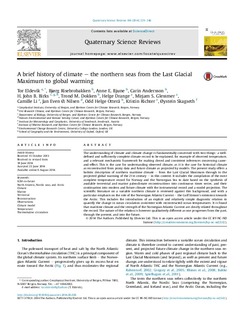| dc.contributor.author | Eldevik, Tor | |
| dc.contributor.author | Risebrobakken, Bjørg | |
| dc.contributor.author | Bjune, Anne Elisabeth | |
| dc.contributor.author | Andersson, Carin | |
| dc.contributor.author | Birks, Harry John Betteley | |
| dc.contributor.author | Dokken, Trond Martin | |
| dc.contributor.author | Drange, Helge | |
| dc.contributor.author | Glessmer, Mirjam Sophia | |
| dc.contributor.author | Li, Camille | |
| dc.contributor.author | Nilsen, Jan Even Øie | |
| dc.contributor.author | Otterå, Odd Helge | |
| dc.contributor.author | Richter, Kristin | |
| dc.contributor.author | Skagseth, Øystein | |
| dc.date.accessioned | 2015-03-04T09:40:04Z | |
| dc.date.accessioned | 2015-04-28T12:08:40Z | |
| dc.date.available | 2015-03-04T09:40:04Z | |
| dc.date.available | 2015-04-28T12:08:40Z | |
| dc.date.issued | 2014-08-06 | |
| dc.identifier.citation | Eldevik, T., Risebrobakken, B., Bjune, A. E., Andersson, C., Birks, H. J. B., Dokken, T. M., . . . Skagseth, Ø. (2014). A brief history of climate – the northern seas from the Last Glacial Maximum to global warming. Quaternary Science Reviews, 106(0), 225-246. doi: http://dx.doi.org/10.1016/j.quascirev.2014.06.028 | nb_NO |
| dc.identifier.issn | 0277-3791 | |
| dc.identifier.uri | http://hdl.handle.net/11250/282677 | |
| dc.description | - | nb_NO |
| dc.description.abstract | The understanding of climate and climate change is fundamentally concerned with two things: a well-defined and sufficiently complete climate record to be explained, for example of observed temperature, and a relevant mechanistic framework for making closed and consistent inferences concerning cause-and-effect. This is the case for understanding observed climate, as it is the case for historical climate as reconstructed from proxy data and future climate as projected by models. The present study offers a holistic description of northern maritime climate – from the Last Glacial Maximum through to the projected global warming of the 21st century – in this context. It includes the compilation of the most complete temperature record for Norway and the Norwegian Sea to date based on the synthesis of available terrestrial and marine paleoclimate reconstructions into continuous times series, and their continuation into modern and future climate with the instrumental record and a model projection. The scientific literature on a variable northern climate is reviewed against this background, and with a particular emphasis on the role of the Norwegian Atlantic Current – the Gulf Stream's extension towards the Arctic. This includes the introduction of an explicit and relatively simple diagnostic relation to quantify the change in ocean circulation consistent with reconstructed ocean temperatures. It is found that maritime climate and the strength of the Norwegian Atlantic Current are closely related throughout the record. The nature of the relation is however qualitatively different as one progresses from the past, through the present, and into the future. | nb_NO |
| dc.language.iso | eng | nb_NO |
| dc.publisher | Elsevier | nb_NO |
| dc.rights | Navngivelse-Ikkekommersiell-IngenBearbeidelse 3.0 Norge | * |
| dc.rights.uri | http://creativecommons.org/licenses/by-nc-nd/3.0/no/ | * |
| dc.title | A brief history of climate – the northern seas from the Last Glacial Maximum to global warming | nb_NO |
| dc.type | Journal article | nb_NO |
| dc.type | Peer reviewed | nb_NO |
| dc.date.updated | 2015-03-04T09:40:03Z | |
| dc.subject.nsi | VDP::Matematikk og naturvitenskap: 400::Geofag: 450 | nb_NO |
| dc.subject.nsi | VDP::Mathematics and natural scienses: 400::Geosciences: 450 | nb_NO |
| dc.source.pagenumber | 225-246 | nb_NO |
| dc.source.volume | 106 | nb_NO |
| dc.source.journal | Quaternary science reviews | nb_NO |
| dc.identifier.doi | 10.1016/j.quascirev.2014.06.028 | |
| dc.identifier.cristin | 1194550 | |

